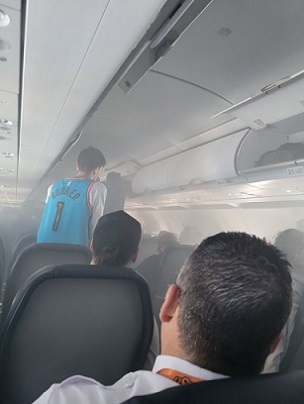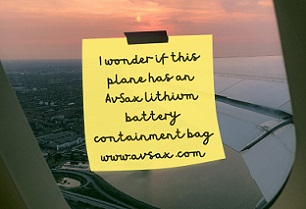 The last place you want a lithium battery fire is in the confined space of a passenger aircraft
The last place you want a lithium battery fire is in the confined space of a passenger aircraft
 A pilot with an AvSax lithium battery fire mitigation bag
A pilot with an AvSax lithium battery fire mitigation bag
 Have you ever thought if your aircraft has an AvSax on board to deal with a lithium battery fire?
Have you ever thought if your aircraft has an AvSax on board to deal with a lithium battery fire?
 AvSax lithium battery fire containment bags means aircraft can continue to their final destinations safely
AvSax lithium battery fire containment bags means aircraft can continue to their final destinations safely
The potential danger posed by lithium batteries on aircraft is now out in the public domain since warnings about them became part of the pre-flight safety briefing.
Cabin crew will tell you about lifejackets and oxygen masks but possibly the more important part of the safety briefing is to urge passengers to let them know if their mobile phone, laptop, iPad, battery charging pack, vape or any other personal electronic device starts to overheat or smoulder.
These incidents are happening but have you ever wondered what the crew would do if a lithium battery fire actually broke out on your plane, sending toxic smoke through the cabin at 35,000ft?
Well, many airlines now carry AvSax lithium battery fire mitigation bags that you’ll never see as they are packed away on the aircraft but within easy reach for the crew should a lithium battery emergency happen.
AvSax are now on board around 16,750 aircraft operated by more than 100 airline companies worldwide. In short, they are the benchmark for lithium battery fire suppression bags and the best selling aircraft lithium safety ‘burnbag’ by far.
The reason is that it meets the airline industry recommendation that a lithium battery bag shouldn’t just contain the overheating device, it should continually cool it down too which the AvSax does. Lithium batteries don’t need oxygen to keep flaring up but cooling them is the most effective way to tackle them. The AvSax is made from military grade material so if the device does explode, the debris will be contained within the bag.
Imagine if this happened and the device wasn’t safely contained in an AvSax. It would send sharp debris flying around the passenger cabin, potentially causing severe injuries and even catastrophic damage to the aircraft.
The way AvSax works is that the overheating device is put in the bag and then a couple of litres of water is added. This causes the gelling polymer inside the bag to expand and close around the device, cooling it.
When lithium batteries overheat they go into what’s known as thermal runaway which happens when one cell in a battery overheats it can produce enough heat – up to 900°C (1652°F) – to cause adjacent cells to overheat. This can cause a lithium battery fire to flare repeatedly and they are very difficult to put out which is why it must go into an AvSax as quickly as possible.
A pilot recently told the media that if they have a lithium battery incident on board then they would divert and make an emergency landing at the nearest airport. This can be incredibly costly for the airline – potentially costing hundreds of thousands of dollars - and very disruptive to the passengers.
Once the lithium battery is in the AvSax the plane can continue its journey. AvSax have been deployed in action 33 times on board aircraft since 2017 and on every occasion the aircraft was able to continue safely to its destination with no need to divert or make an emergency landing.
The reason AvSax are so effective and are the main choice for airlines is that these thermal containment bags are designed to continually cool the overheating battery using water poured into the bag.
This use of liquid is recommended by the Civil Aviation Authority (CAA) in the UK and many other fire containment bags don’t work this way.
In its guidance the CAA states: “Since the development of the International Civil Aviation Organization (ICAO) guidance on dealing with an in-flight battery fire, new products designed for use in response to lithium battery thermal runaway events have become available.
“Products which provide both a cooling and containment capability are typically more aligned to the existing ICAO guidance as when used they are filled with water or other non-flammable liquid to act as a cooling agent.
“After knocking down flames it could conceivably take just a couple of seconds for a personal electronic device to be placed inside a containment bag, allowing it to be moved to a place of safety. Passengers could then return to their seats, mitigating potential unrelated safety hazards such as injury in the case of severe turbulence. Equally, the effect on flight crew in carrying out their duties following an event on the flight deck would be minimised.”
AvSax were devised by Environmental Defence Systems Ltd based in Huddersfield, West Yorkshire and the company won the Queen’s Award for Enterprise for their innovation in the UK – the top accolade any business can get.
Managing director Richard Bailey said: “It may seem strange to use water to stifle a fire in an electronic device but the water is mainly absorbed into the sides of the bag which then expand.
“Lithium battery fires are notoriously difficult to put out as we have seen on a larger scale with batteries used to power electric cars, e-scooters and e-bikes. They don’t need oxygen to keep flaring up so can reignite quite some time after they initially caught fire. The only way to effectively deal with it is to cool them down which is exactly what the AvSax is designed to do.”
If you want to read more about lithium battery fires on board aircraft our blog is probably the most comprehensive one in the world.
Read more at https://avsax.com/news